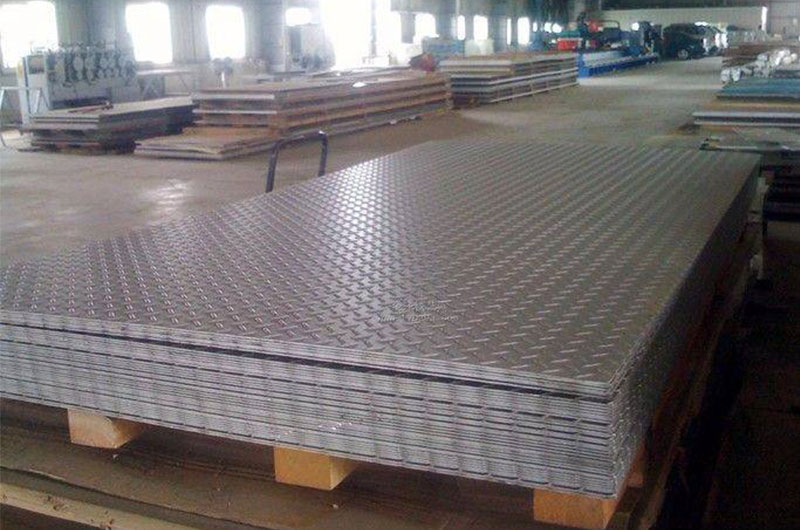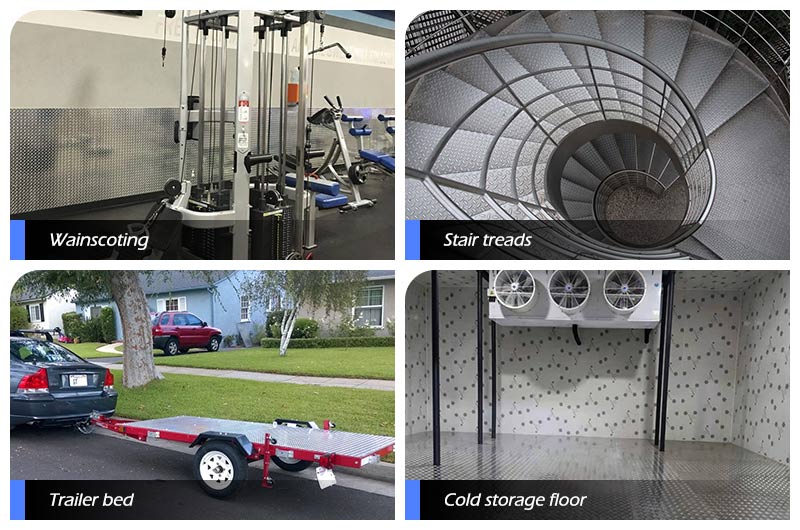How is the Aluminum Checker Plate Manufactured?
Updated : Dec. 13, 2023Aluminum Checker Plate, sometimes also referred to as Aluminum Diamond Plate, Aluminum Flooring, or Aluminum Tread Plate, is a type of aluminum rolled sheet. It features a raised diamond or linear pattern on one side, while the other side remains smooth.
The raised pattern ensures slip resistance, while the shiny aluminum surface provides an attractive appearance. This is why Aluminum Checker Plate is so widely popular.

Production processes of aluminum checker plate
Mechanical pressing
Mechanical pressing is a method used to create diamond patterns on aluminum sheets. In this process, molds with the desired patterns are used to mechanically press the aluminum sheet into shape. Mechanical pressing results in a surface with a very smooth diamond plate pattern.
Hot rolling
Hot rolling is the most commonly used method for producing aluminum checker plates and diamond plates. In this process, the aluminum sheet passes through a series of rollers, deforming it into the desired shape. Hot rolling can produce a smooth surface and a uniform texture.
Chemical etching
Chemical etching can be employed to create surfaces with more textured patterns. In chemical etching, the aluminum sheet is immersed in a chemical bath, which etches away the surface, leaving behind raised patterns. Chemical etching can produce various patterns, including checkerboard patterns, diamond patterns, and waffle grid patterns.
Sandblasting
Sandblasting is used to create textured surfaces on aluminum checker plates or diamond plates. In sandblasting, sand or other abrasives are blasted onto the aluminum sheet, removing the surface and leaving behind raised patterns.
Mechanical embossing vs. Hot rolling embossing
Mechanical embossing (Stamping)
Stamping involves using older production equipment where aluminum sheets are first cut and flattened before being individually placed into embossing equipment for pressing.
The pattern direction varies for each embossed aluminum sheet, resulting in lower production efficiency. Stamping technology is no longer commonly used.
Hot rolling (Rolling press)
Another method is rolling press, a continuous production process where the aluminum sheet is directly pressed onto a coil using a rolling machine and embossing equipment.
This ensures consistent pattern direction within the same batch, offering higher production efficiency. For producers, this method is more economically efficient.
After rolling, various patterns appear on the surface of the aluminum sheet. However, the process is not complete, and subsequent processing steps such as cutting, annealing, flatness correction, and anodizing are still required.

Use of aluminum checker plate embossing machine
In the hot rolling production of checker plates, the embossing machine plays a crucial role. Turn on the main switch of the embossing machine.Insulate the lower die and install the upper die at the top.
Press the test mode switch, adjusting the fitting position of the upper and lower dies.
The final product's effect on the embossing machine is determined by temperature, adjusting output power, pressure, and the high cycle time of output.

How to evaluate the quality of patterned aluminum sheets
- Check the pattern formation rate, pattern height, and pattern height difference of the aluminum checker plate.
- Observe the external appearance of the patterned aluminum sheet to identify any noticeable scratches, bubbles, oil stains, or other impurities on the surface.
- Ensure the patterned aluminum sheet has uniform thickness without variations.
- Verify whether the hardness and strength of the patterned aluminum sheet meet the specified requirements.
- Examine the flatness of the patterned aluminum sheet to ensure it meets the desired standards.
Maintenance and care of aluminum checker plate
To maintain the aesthetics and slip resistance of aluminum checker plates, regular cleaning and maintenance are crucial.
- Clean residual dirt between patterns using soapy water and a brush.
- Harsh acids or alkalis can damage the aluminum surface, so choose mild cleaning agents.
- Inspect for any signs of wear or damage and replace promptly if needed.
As checker plates are typically used in environments prone to wear, such as industrial floors and vehicle platforms, they can retain their slip resistance when well-maintained.
Through continuous maintenance, corrosion and damage can be prevented, thereby extending the material's lifespan. Maintenance is a small investment that can bring significant returns in terms of safety, functionality, and longevity.
Advantages of aluminum checker plate
The surface of aluminum checker plate features various aesthetically pleasing pattern designs.
- Provides slip resistance in wet or oily conditions.
- The surface of aluminum checker plate undergoes oxidation treatment, offering excellent corrosion resistance.
- Aluminum checker plate exhibits high strength and rigidity.
- Due to its lightweight nature, especially in vehicle applications, it reduces overall vehicle weight.
- Aluminum checker plate can meet various processing needs.
- Easy to install, maintain, and clean.
- The material is recyclable.
Aluminum checker plate vs Steel checker plate
Weight difference
Aluminum checker plate is relatively lightweight, suitable for applications that require a lightweight structure.
Steel is heavier, offering increased strength and durability compared to aluminum checker plate.
Corrosion resistance
Aluminum checker plate exhibits excellent corrosion resistance, maintaining stability in damp and corrosive environments.
Steel checker plate is prone to rust in moist conditions, often requiring surface treatment to enhance corrosion resistance.
Processing and forming
Aluminum checker plate is easy to process and shape, suitable for various processing techniques such as cutting, bending, and embossing.
Steel checker plate also has good processing properties but may require stronger force and equipment compared to aluminum checker plate.
Appearance difference
The surface of aluminum checker plate is typically smooth and bright, providing a modern and attractive appearance.
Steel checker plate may have a more solid and classic appearance, suitable for applications that require a rugged exterior.
Aluminum checker plate alloys and corresponding applications
1050 and 1060 aluminum checker plate
Lower strength but excellent corrosion resistance and good processing performance.
Not suitable for heat treatment but economically viable, used in chemical storage, processing equipment, kitchen utensils, and general sheet metal processing.
3003 and 3103 aluminum checker plate
Slightly higher strength, average rust resistance, good bendability, and weldability.
Not suitable for heat treatment, widely used in food and chemical equipment, electrical components, truck and trailer roofs, heat exchangers, and lawn furniture components.

4017 aluminum checker plate
Good weldability and bendability, moderate wear and corrosion resistance.
Applied in truck beds and trailers, walkways and catwalks, flooring, wall panels, as well as decorative and construction purposes.
5052, 5083, and 5754 aluminum checker plate
Excellent corrosion resistance, hardness, and rust resistance with high load-bearing capacity.
Suitable for large ships, containers, train cars, structures, and elevator cabins.
Also used in dump truck bodies, exhaust chimneys, ship components, and chemical processing containers. Not recommended for decorative purposes.
6061 and 6082 aluminum checker plate
Outstanding corrosion resistance, high strength, superior processing, and welding characteristics.
Not suitable for bending. Commonly used in special environments with high corrosion requirements such as non-skid protection on ship decks, shipbuilding projects, and in energy and chemical industries under corrosive conditions.
Overall, aluminum checker plates find widespread applications across various industries due to their aesthetic appeal, slip resistance, high strength, corrosion resistance, and ease of processing.
Regular maintenance ensures prolonged performance, making them an economical, efficient, and environmentally friendly solution. The specific choice of aluminum checker plate depends on the particular application and requirements.




